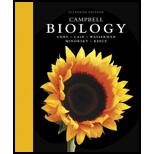
Campbell Biology (11th Edition)
11th Edition
ISBN: 9780134093413
Author: Lisa A. Urry, Michael L. Cain, Steven A. Wasserman, Peter V. Minorsky, Jane B. Reece
Publisher: PEARSON
expand_more
expand_more
format_list_bulleted
Question
Chapter 42, Problem 3TYU
Summary Introduction
Concept introduction: Pulse is the rhythmical throbbing of arteries generated by the regular contractions of the heart, especially felt as palpated at the wrist or in the neck.
Expert Solution & Answer
Want to see the full answer?
Check out a sample textbook solution
Students have asked these similar questions
What are the structure and properties of atoms and chemical bonds (especially how they relate to DNA and proteins).
The Sentinel Cell: Nature’s Answer to Cancer?
Molecular Biology Question
You are working to characterize a novel protein in mice. Analysis shows that high levels of the primary transcript that codes for this protein are found in tissue from the brain, muscle, liver, and pancreas. However, an antibody that recognizes the C-terminal portion of the protein indicates that the protein is present in brain, muscle, and liver, but not in the pancreas. What is the most likely explanation for this result?
Chapter 42 Solutions
Campbell Biology (11th Edition)
Ch. 42.1 - Prob. 1CCCh. 42.1 - Three-chambered hearts with incomplete septa were...Ch. 42.1 - Prob. 3CCCh. 42.2 - Explain why blood has a higher 02 concentration in...Ch. 42.2 - Prob. 2CCCh. 42.2 - Prob. 3CCCh. 42.3 - Prob. 1CCCh. 42.3 - Prob. 2CCCh. 42.3 - Prob. 3CCCh. 42.4 - Explain why a physician might order a white cell...
Ch. 42.4 - Prob. 2CCCh. 42.4 - Prob. 3CCCh. 42.4 - Prob. 4CCCh. 42.5 - Why is an internal location for gas exchange...Ch. 42.5 - Prob. 2CCCh. 42.5 - MAKE CONNECTIONS Describe similarities in the...Ch. 42.6 - Prob. 1CCCh. 42.6 - Prob. 2CCCh. 42.6 - Prob. 3CCCh. 42.7 - What determines whether O2 and CO2 undergo net...Ch. 42.7 - How does the Bohr shift help deliver O2 to very...Ch. 42.7 - Prob. 3CCCh. 42 - How does the flow of a fluid in a closed...Ch. 42 - Prob. 42.2CRCh. 42 - Prob. 42.3CRCh. 42 - Prob. 42.4CRCh. 42 - Prob. 42.5CRCh. 42 - How does air in the lungs differ from the fresh...Ch. 42 - How are the roles of a respiratory pigment and an...Ch. 42 - Prob. 1TYUCh. 42 - Blood returning to the mammalian heart in a...Ch. 42 - Prob. 3TYUCh. 42 - When you hold your breath, which of the following...Ch. 42 - Prob. 5TYUCh. 42 - Prob. 6TYUCh. 42 - Prob. 7TYUCh. 42 - DRAW IT Plot blood pressure against time for one...Ch. 42 - EVOLUTION CONNECTION One opponent of the movie...Ch. 42 - Prob. 10TYUCh. 42 - Prob. 11TYUCh. 42 - WRITE ABOUT A THEME: INTERACTIONS Some athletes...Ch. 42 - Prob. 13TYU
Knowledge Booster
Similar questions
- Molecular Biology Explain/discuss how “slow stop” and “quick/fast stop” mutants wereused to identify different protein involved in DNA replication in E. coli.arrow_forwardMolecular Biology Question A gene that codes for a protein was removed from a eukaryotic cell and inserted into a prokaryotic cell. Although the gene was successfully transcribed and translated, it produced a different protein than it produced in the eukaryotic cell. What is the most likely explanation?arrow_forwardMolecular Biology LIST three characteristics of origins of replicationarrow_forward
- Molecular Biology Question Please help. Thank you For E coli DNA polymerase III, give the structure and function of the b-clamp sub-complex. Describe how the structure of this sub-complex is important for it’s function.arrow_forwardMolecular Biology LIST three characteristics of DNA Polymerasesarrow_forwardMolecular Biology RNA polymerase core enzyme structure contains what subunits? To form holo enzyme, sigma factor is added to core. What is the name of the structure formed? Give the detailed structure of sigma factor and the function of eachdomain. Please help. Thank youarrow_forward
- Molecular Biology You have a single bacterial cell whose DNA is labelled with radioactiveC14. After 5 rounds of cell division, how may cells will contain radioactive DNA? Please help. Thank youarrow_forward1. Explain the structure and properties of atoms and chemical bonds (especially how they relate to DNA and proteins). Also add some pictures.arrow_forward1. In the Sentinel Cell DNA integrity is preserved through nanoscopic helicase-coordinated repair, while lipids in the membrane are fortified to resist environmental mutagens. also provide pictures for this question.arrow_forward
- Explain the structure and properties of atoms and chemical bonds (especially how they relate to DNA and proteins). Also add some pictures.arrow_forwardIn the Sentinel Cell DNA integrity is preserved through nanoscopic helicase-coordinated repair, while lipids in the membrane are fortified to resist environmental mutagens. also provide pictures for this question.arrow_forward1. Explain how genetic information is stored, copied, transferred, and expressed. Also add some pictures for this question.arrow_forward
arrow_back_ios
SEE MORE QUESTIONS
arrow_forward_ios
Recommended textbooks for you
 Human Physiology: From Cells to Systems (MindTap ...BiologyISBN:9781285866932Author:Lauralee SherwoodPublisher:Cengage Learning
Human Physiology: From Cells to Systems (MindTap ...BiologyISBN:9781285866932Author:Lauralee SherwoodPublisher:Cengage Learning Human Biology (MindTap Course List)BiologyISBN:9781305112100Author:Cecie Starr, Beverly McMillanPublisher:Cengage Learning
Human Biology (MindTap Course List)BiologyISBN:9781305112100Author:Cecie Starr, Beverly McMillanPublisher:Cengage Learning Principles Of Radiographic Imaging: An Art And A ...Health & NutritionISBN:9781337711067Author:Richard R. Carlton, Arlene M. Adler, Vesna BalacPublisher:Cengage Learning
Principles Of Radiographic Imaging: An Art And A ...Health & NutritionISBN:9781337711067Author:Richard R. Carlton, Arlene M. Adler, Vesna BalacPublisher:Cengage Learning

Human Physiology: From Cells to Systems (MindTap ...
Biology
ISBN:9781285866932
Author:Lauralee Sherwood
Publisher:Cengage Learning


Human Biology (MindTap Course List)
Biology
ISBN:9781305112100
Author:Cecie Starr, Beverly McMillan
Publisher:Cengage Learning


Principles Of Radiographic Imaging: An Art And A ...
Health & Nutrition
ISBN:9781337711067
Author:Richard R. Carlton, Arlene M. Adler, Vesna Balac
Publisher:Cengage Learning
